Monthly Archives: July 2024

 My grandniece, Zoey Iverson is growing up so fast…maybe faster than most nine-year-olds maybe, but Zoey has taken her sister role very seriously. No one pushed that on her, she just knew that her brother, Lucas Iverson needed more than an average sister. Lucas is a Down Syndrome child, and his development was a little slower than most kids, bit Zoey wanted to help him get on track, and so she set her mind to it. When she sets her mind to something, Zoey gets it done. She loved her big brother so much, and she wanted to help make his life better. Now she is also big sister to her little sister, Alicen Burr, and she is enjoying that so much. Zoey is a sweet
My grandniece, Zoey Iverson is growing up so fast…maybe faster than most nine-year-olds maybe, but Zoey has taken her sister role very seriously. No one pushed that on her, she just knew that her brother, Lucas Iverson needed more than an average sister. Lucas is a Down Syndrome child, and his development was a little slower than most kids, bit Zoey wanted to help him get on track, and so she set her mind to it. When she sets her mind to something, Zoey gets it done. She loved her big brother so much, and she wanted to help make his life better. Now she is also big sister to her little sister, Alicen Burr, and she is enjoying that so much. Zoey is a sweet  and happy girl, and she loves making her siblings happy. She is such a great blessing to her parents, Cassie Iverson and bonus dad, William Burr. Her life is so blessed by them, and in turn, she makes their lives richer, just by being herself.
and happy girl, and she loves making her siblings happy. She is such a great blessing to her parents, Cassie Iverson and bonus dad, William Burr. Her life is so blessed by them, and in turn, she makes their lives richer, just by being herself.
Zoey is such a smart girl. She really excelled in school this year, and she has continued to learn things over the summer. I’m sure she is reading to her siblings and showing them the things she has learned. Zoey is also very crafty. That will be another thing she can help her siblings do. It may be coloring for now, but later on, the sky’s the limit. I have always envied people who are crafty. Their imaginations are amazing. They can picture an item in their mind, and then create it in real life. Zoey is one of 
 those amazing people. She is into selling things to make money…so she can do more crafts!! What else would Zoey want to spend craft money on?
those amazing people. She is into selling things to make money…so she can do more crafts!! What else would Zoey want to spend craft money on?
The big news right now is that Zoey is heading to church camp for a week. Her mom is excited for her, but she will miss her too. Cassie is hoping to send some letters via messenger or text to her (via email) while she is there. While the week will go by fast, it doesn’t always feel that way to the family at home. Nevertheless, I know that Zoey is going to have the time of her life, and what a great birthday week for her. Today is Zoey’s 9th birthday. Happy birthday Zoey!! Have a great day!! We love you!!

 The mission began on July 29, 1953. The B-50 Superfortress piloted by Captain Stanley K O’Kelley had a total of seventeen crewmembers aboard. Its mission was a reconnaissance flight over North Korea. It took off from Honshu, Japan. As the plane headed out across the Sea of Japan, on its way to North Korea, it was intercepted and shot down by a pair of MiG-17s (or possibly MiG-15s) piloted by two Soviet pilots (Yablonskiy and Rybakov), south of Askold Island near Vladivostok. They immediately opened fire, and quickly shot down B-50 Superfortress number 15830. The plane crashed into the Sea of Japan. Amazingly, there was one survivor, and unfortunately, the rest of the crew died in the crash.
The mission began on July 29, 1953. The B-50 Superfortress piloted by Captain Stanley K O’Kelley had a total of seventeen crewmembers aboard. Its mission was a reconnaissance flight over North Korea. It took off from Honshu, Japan. As the plane headed out across the Sea of Japan, on its way to North Korea, it was intercepted and shot down by a pair of MiG-17s (or possibly MiG-15s) piloted by two Soviet pilots (Yablonskiy and Rybakov), south of Askold Island near Vladivostok. They immediately opened fire, and quickly shot down B-50 Superfortress number 15830. The plane crashed into the Sea of Japan. Amazingly, there was one survivor, and unfortunately, the rest of the crew died in the crash.
Captain John Ernst Roche was that survivor, and when it became known that the bomber had failed to return, a search was started. It was thought that some of the other crew might have survived, and life rafts were dropped, but no one else was saved in the end. It was thought that at least four of them (and possibly more) were seen sitting in the raft. Also seen were nine Soviet PT-type boats in the area and at least six of them were heading to the location where debris from the aircraft was later discovered. A Soviet trawler was also spotted in the approximate area. Knowing that, I suppose any of the other survivors were killed. The United States conducted a thorough search of the area by air and sea and was assisted by an Australian ship near the crash site. The search was halted due to dense fog and approaching darkness, and the search was resumed on the morning of July 30, 1953. Captain John Roche, co-pilot of the plane, was wounded but survived the crash by holding onto pieces of the wreckage. He was finally picked up by the Navy ship USS Picking in the early morning hours of July 30, 1953, after floating in the Sea of Japan for about 22 hours. Unfortunately, no other survivors were found. The bodies of Captain Stanley O’Kelley and Master Sergeant Francis Brown were later recovered along the coast of Japan. The remaining 14 members of the crew, which included Robert Stalnaker, were never found. The crew members were First Lieutenant Frank E Beyer (MIA), Master Sergeant Francis L Brown (body recovered), First Lieutenant Edmund J Czyc (MIA), Staff Sergeant Donald W Gabree, (MIA), Airman First Class Roland E Goulet (status unknown), Staff Sergeant Donald G Hill (MIA), First Lieutenant James G Keith (KIA), Captain Stanley K O’Kelley (body recovered), Airman Second Class Earl W Radelin Jr (MIA), Captain John E Roche (rescued the next day on July 30, 1953), Airman Second Class, Charles J Russell (MIA), First Lieutenant Warren J Sanderson (MIA), First Lieutenant Robert E Stalnaker (MIA), Major Francisco J Tejeda (MIA), Captain John C Ward (MIA), First Lieutenant Lloyd C Wiggins (MIA), and Airman Second Class James E Woods (MIA).
The B50 Superfortress number 47-145 (Manufacture Number 15830) was built by Boeing. It was delivered to the US Air Force (USAF) as B-50B-50-BO Superfortress serial number 47-145. So that the bomber could be 
 used as a spy plane, it was modified as RB-50G ELINT with additional radar and B-50D type nose, sometimes also referred to as RB-50D. It was then assigned as a spy plane, to the 91st Strategic Reconnaissance Squadron (91st SRS) based at Yokato AFB. It was working in that capacity when it was shot down.
used as a spy plane, it was modified as RB-50G ELINT with additional radar and B-50D type nose, sometimes also referred to as RB-50D. It was then assigned as a spy plane, to the 91st Strategic Reconnaissance Squadron (91st SRS) based at Yokato AFB. It was working in that capacity when it was shot down.

 The beginning of my niece, Raelynn Masterson’s life story is really a little funny…not because Raelynn was funny, but because her mom, Dustie Masterson was. Raelynn was Dustie’s first child, and when she went into labor on this day 21 years ago, her husband, my nephew, Rob Masterson told her that she was in labor. That made sense, because he had been through this situation once before, with his daughter, Christina from his first marriage. Anyway, Rob was certain that Dustie was in labor, but as Dustie says, “I remember it very clearly Rob said I was in labor and my whole 22-year-old wisdom argument was that I couldn’t be in labor because I hadn’t had my baby shower yet.” Well, as every parent knows, labor waits for no man, woman, or baby shower.
The beginning of my niece, Raelynn Masterson’s life story is really a little funny…not because Raelynn was funny, but because her mom, Dustie Masterson was. Raelynn was Dustie’s first child, and when she went into labor on this day 21 years ago, her husband, my nephew, Rob Masterson told her that she was in labor. That made sense, because he had been through this situation once before, with his daughter, Christina from his first marriage. Anyway, Rob was certain that Dustie was in labor, but as Dustie says, “I remember it very clearly Rob said I was in labor and my whole 22-year-old wisdom argument was that I couldn’t be in labor because I hadn’t had my baby shower yet.” Well, as every parent knows, labor waits for no man, woman, or baby shower.
Still, Raelynn was six weeks early, so Dustie had no reason to expect that her baby shower wouldn’t be early enough. Nevertheless, Raelynn was perfect, and they went home 2 days later. She was a miracle all the way 
 around. Dustie didn’t think she was able to have children, and yet here was proof that they could. God’s plans were higher than the plans of men. Rae (as he is always called), is such a beautiful person inside and out. She has a big heart, and a great sense of humor. She is funny without even trying, which is the best kind of humor according to her mom, and I agree. Dustie thinks that one of Rae’s best attributes is her courage. Raelynn puts her mind to something, and she does it. She might be nervous, but she doesn’t let fear overtake her. From a talent show at school, to running for school office (earning her the nickname Rae Rae the Rapper) she rapped her entire speech, to major back surgery she doesn’t back down. Raelynn had Scoliosis, and it took a full back surgery to correct it. Regular high school was not for Raelynn, but she is working on her GED, and from there, she will figure out where she wants to go in life. They have faith in her abilities and know she can do whatever she wants. Her parents are excited to see where life will take their girl.
around. Dustie didn’t think she was able to have children, and yet here was proof that they could. God’s plans were higher than the plans of men. Rae (as he is always called), is such a beautiful person inside and out. She has a big heart, and a great sense of humor. She is funny without even trying, which is the best kind of humor according to her mom, and I agree. Dustie thinks that one of Rae’s best attributes is her courage. Raelynn puts her mind to something, and she does it. She might be nervous, but she doesn’t let fear overtake her. From a talent show at school, to running for school office (earning her the nickname Rae Rae the Rapper) she rapped her entire speech, to major back surgery she doesn’t back down. Raelynn had Scoliosis, and it took a full back surgery to correct it. Regular high school was not for Raelynn, but she is working on her GED, and from there, she will figure out where she wants to go in life. They have faith in her abilities and know she can do whatever she wants. Her parents are excited to see where life will take their girl.
Her sister, Taylor Masterson, tells me that in the past year, Rae has started spending more time with her and their brother, Matt Masterson. The siblings are growing closer and closer every day. They like to go to the movies, and in general, they have been working on getting her out of the house more than she used to. Raelyn 
 loves animals and has grown closer to the family pets too. She tends to be shy, but lately, she has been working on being more social. Being shy myself, I know how hard that can be. Socializing on Facebook is easy, but the face-to-face stuff is harder. One of the coolest things is that for Taylor, her big sister, Rae is “one of my biggest role models and one of my biggest supporters” as well. Taylor says, “I love my older sister more than words can describe and I am so glad she is my sister!!” Today is Raelynn’s 21st birthday. Happy birthday Rae!! Have a great day!! We love you!!
loves animals and has grown closer to the family pets too. She tends to be shy, but lately, she has been working on being more social. Being shy myself, I know how hard that can be. Socializing on Facebook is easy, but the face-to-face stuff is harder. One of the coolest things is that for Taylor, her big sister, Rae is “one of my biggest role models and one of my biggest supporters” as well. Taylor says, “I love my older sister more than words can describe and I am so glad she is my sister!!” Today is Raelynn’s 21st birthday. Happy birthday Rae!! Have a great day!! We love you!!
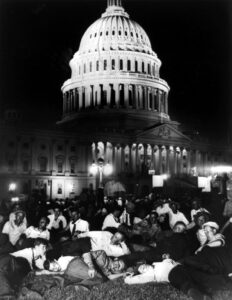
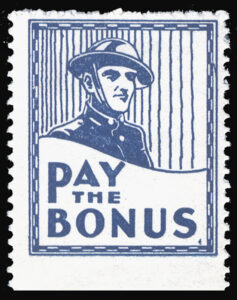 Following their service in World War I, veterans were given a veterans’ bonus certificates…basically an I.O.U. from the government. When the Great Depression hit, and many veterans were out of work, the certificates became essentially worthless…at least for the time being. That was unacceptable to the veterans, who had been promised a bonus, and now they really needed it.
Following their service in World War I, veterans were given a veterans’ bonus certificates…basically an I.O.U. from the government. When the Great Depression hit, and many veterans were out of work, the certificates became essentially worthless…at least for the time being. That was unacceptable to the veterans, who had been promised a bonus, and now they really needed it.
As you would expect, telling people that the money they need today, will be coming to them down the road…eventually, is not going to go over well. In May, the so-called “Bonus Expeditionary Force,” a group of some 1,000 World War I veterans seeking cash payments for their veterans’ bonus certificates arrived in Washington DC. These men were unemployed and desperate. So began the protests by the “Bonus Marchers.” Most of the marchers were in 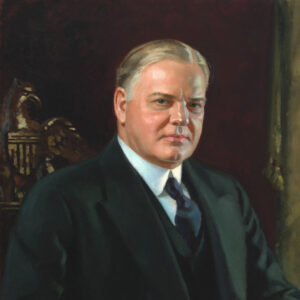 financial straits, and they were either going to get paid, or they were going to go under. That was unacceptable for these loyal veterans, who felt that they were getting a bum deal. In June, more veteran groups spontaneously made their way to the nation’s capital, bringing the Bonus Marchers to nearly 20,000 strong. They were camping in vacant government buildings and in open fields made available by District of Columbia Police Chief Pelham D Glassford. The Bonus Marchers were demanding passage of the veterans’ payment bill introduced by Representative Wright Patman, and they wanted it passed now.
financial straits, and they were either going to get paid, or they were going to go under. That was unacceptable for these loyal veterans, who felt that they were getting a bum deal. In June, more veteran groups spontaneously made their way to the nation’s capital, bringing the Bonus Marchers to nearly 20,000 strong. They were camping in vacant government buildings and in open fields made available by District of Columbia Police Chief Pelham D Glassford. The Bonus Marchers were demanding passage of the veterans’ payment bill introduced by Representative Wright Patman, and they wanted it passed now.
To their credit, the veterans conducted themselves in an orderly and peaceful fashion as they waited for the vote. Finally, on June 15 the Patman bill passed in the House of Representatives. Unfortunately, two days later, it was defeated in the Senate, and the marchers were furious. They refused to leave the area. The government was trying to defuse the situation and clear the area, so they agreed to provide money for the protesters’ trip home, but 2,000 protesters refused 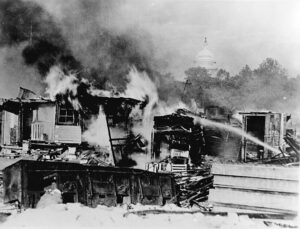
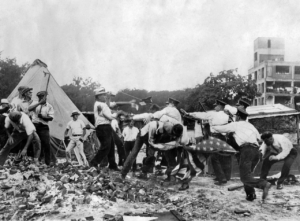 the offer and continued to protest. Then, on July 28, President Herbert Hoover ordered the army to evict them forcibly. It was an order that would not end well. General MacArthur’s men set the protesters’ camps on fire, and the veterans were forced to leave the city. Hoover was increasingly regarded as insensitive to the needs of the nation’s many poor. He was strongly criticized by the public and press for the severity of his response.
the offer and continued to protest. Then, on July 28, President Herbert Hoover ordered the army to evict them forcibly. It was an order that would not end well. General MacArthur’s men set the protesters’ camps on fire, and the veterans were forced to leave the city. Hoover was increasingly regarded as insensitive to the needs of the nation’s many poor. He was strongly criticized by the public and press for the severity of his response.

 The 2024 Summer Olympic games officially opened yesterday in Paris. There were a number of great entries in the parade, and as always, the Torch Relay did not disappoint. I think my favorite person in the relay was Kevin Piette…the 36-year-old man, who had been paralyzed from the waist down since he was 11 years old, was in an exoskeleton unit, and he was actually able to walk!! What a thrilling moment that must have been for him!! He looked beyond happy!!
The 2024 Summer Olympic games officially opened yesterday in Paris. There were a number of great entries in the parade, and as always, the Torch Relay did not disappoint. I think my favorite person in the relay was Kevin Piette…the 36-year-old man, who had been paralyzed from the waist down since he was 11 years old, was in an exoskeleton unit, and he was actually able to walk!! What a thrilling moment that must have been for him!! He looked beyond happy!!
The Olympics have changed over the many years since they began. The first Olympics was in took place from April 6–15, 1896 in Athens, Greece. The athletes in those first games actually competed in the nude. In the ancient Olympic Games in Greece, athletes competed in the nude as homage to supreme god Zeus in celebration of manhood, strength, physique, and dominant status. Ok, well whatever, but I think it’s much better to wear clothes…especially in such a public place.
The events in the Olympics have changed a lot through the years too. From 1912 to 1948, the Olympic Games actually held competitions in the fine arts. Medals were given for literature, architecture, sculpture, painting, 
 and music. The only stipulation was that the art created was required to be Olympic-themed. Ok, easy enough, if it allows you to compete. Sports like croquet, cricket, Jeu de Paume (the original tennis), Lacross, motor boating, Pelota (a type of racquetball), polo, roque, rackets, and even tug-of-war, found their way into the famed event. I suppose the idea was to include as many groups as possible for the purpose of inclusion.
and music. The only stipulation was that the art created was required to be Olympic-themed. Ok, easy enough, if it allows you to compete. Sports like croquet, cricket, Jeu de Paume (the original tennis), Lacross, motor boating, Pelota (a type of racquetball), polo, roque, rackets, and even tug-of-war, found their way into the famed event. I suppose the idea was to include as many groups as possible for the purpose of inclusion.
The Olympic games are divided into three separate events. The Winter Olympics, the Summer Olympics, and the three-year-old Paralympic Games. Being a summer person, I prefer the Summer Olympics, but there are events I like in the Winter Olympics too. If it were possible to combine the two, there would not be enough time to get all the events in. Of course, that isn’t really possible anyway, because of the need for very different 
 weather for some events. This year’s Summer Olympics are being held now in Paris, France and started yesterday, July 26, 2024. They will wrap up on August 11, 2024. The Winter Olympics will take place in Milan and Cortina d’Ampezzo, Italy, February 6, 2026, and wrapping up on February 22, 2026. The Paralympic Games will take place in Milan and Cortina d’Ampezzo, Italy, opening on March 6, 2026, and wrapping up on March 15, 2026. The Olympics has something for everyone.
weather for some events. This year’s Summer Olympics are being held now in Paris, France and started yesterday, July 26, 2024. They will wrap up on August 11, 2024. The Winter Olympics will take place in Milan and Cortina d’Ampezzo, Italy, February 6, 2026, and wrapping up on February 22, 2026. The Paralympic Games will take place in Milan and Cortina d’Ampezzo, Italy, opening on March 6, 2026, and wrapping up on March 15, 2026. The Olympics has something for everyone.

 My grandnephew, Ryder Birky has had a busy year of exploration and growth. You might be thinking that means that he is a young man embarking on a new career or something, but the reality is that Ryder is a little boy of just 2 years. I know, you are thinking, “how could he have changed so much?” And when I accidentally published Ryder’s story a month early, thinking that June was July for some reason, I had written a very different story about Ryder’s life than this one will be, too. On July 4th, little Ryder’s life took an unexpected turn that will change his life and that of his family forever. As his family prepared to celebrate the Independence Day holiday, Ryder’s daddy, Riley Birky and his uncle, Tucker Schulenberg and two friends, Dylan and Landon were in a car with fireworks, when the fireworks were somehow ignited. I don’t need to tell you the ramifications of that. So, the last month of Ryder’s year was spent away from his daddy and his uncle. Thankfully, both Riley and Tucker are doing well, but they will have a long road to full recovery, and Ryder is so young that maybe he won’t know that anything has
My grandnephew, Ryder Birky has had a busy year of exploration and growth. You might be thinking that means that he is a young man embarking on a new career or something, but the reality is that Ryder is a little boy of just 2 years. I know, you are thinking, “how could he have changed so much?” And when I accidentally published Ryder’s story a month early, thinking that June was July for some reason, I had written a very different story about Ryder’s life than this one will be, too. On July 4th, little Ryder’s life took an unexpected turn that will change his life and that of his family forever. As his family prepared to celebrate the Independence Day holiday, Ryder’s daddy, Riley Birky and his uncle, Tucker Schulenberg and two friends, Dylan and Landon were in a car with fireworks, when the fireworks were somehow ignited. I don’t need to tell you the ramifications of that. So, the last month of Ryder’s year was spent away from his daddy and his uncle. Thankfully, both Riley and Tucker are doing well, but they will have a long road to full recovery, and Ryder is so young that maybe he won’t know that anything has 
 changed. His daddy and uncle will just be his daddy and his uncle. Ryder’s mommy, Sierah Martin has been such a strong woman, holding everything together when she could have been falling apart. Because of that the whole family is going to be ok.
changed. His daddy and uncle will just be his daddy and his uncle. Ryder’s mommy, Sierah Martin has been such a strong woman, holding everything together when she could have been falling apart. Because of that the whole family is going to be ok.
I don’t want to make Ryder’s birthday story be all doom and gloom, but this is a part of his history now, and as such, must be told. In reality, much of what has happened this month will someday seem like everyday life for Ryder. We don’t know what his daddy and uncle will look like in the future, but what we do know is that they will always be Riley and Tucker, and they will always be Ryder’s (and his brother, Jace Lee’s) daddy and uncle. And they will always love them to pieces. Ryder’s daddy is a wonderful dad, and he has given his boys the very best that is in him to give. Tucker loves those boys so much, and they love him too. Ryder’s life might never be considered normal or average, but Ryder has his daddy and his uncle, and that is what really matters. Sierah Martin and Riley Birky would normally have their hands full keeping their little “terrible twos” aged child corralled, but Tucker and Jace have been a big help with that. It’s not that they make Tucker babysit the little boys, it’s that Tucker wants to. That is another reason that the current situation is very hard. I think it will also 
 be another reason that Riley and Tucker will work extra hard to get well. They have a beautiful family to get back to.
be another reason that Riley and Tucker will work extra hard to get well. They have a beautiful family to get back to.
While Ryder and Jace have been spending some time with grandparents while their daddy, they got to spend a little time today doing some fun things. They went to the aquarium, went for breakfast, and then got to spend time with their daddy and uncle. That was the very best part of it. Showing Riley and Tucker how much they are loved. This birthday was different. This summer will be different, but this family knows they are very blessed. That is the most important thing. Ryder’s parents are such loving people. That makes Ryder a very happy boy. Today is Ryder’s 2nd birthday. Happy birthday Ryder!! Have a great day!! We love you!!

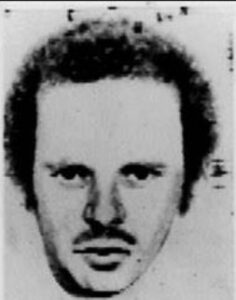 Kirk Bloodsworth was a 23-year-old ex-Marine in 1984, when 9-year-old Dawn Hamilton was brutally raped and beaten to death with a rock. She was then left in a wooded area of Rosedale, Maryland, near her home. The crime was so horrific that it was hard to fathom, but as terrible as it was, there was going to be another victim of this crime.
Kirk Bloodsworth was a 23-year-old ex-Marine in 1984, when 9-year-old Dawn Hamilton was brutally raped and beaten to death with a rock. She was then left in a wooded area of Rosedale, Maryland, near her home. The crime was so horrific that it was hard to fathom, but as terrible as it was, there was going to be another victim of this crime.
During the investigation, witnesses recalled a suspicious man in the area where Miss Hamilton was brutally murdered. A police sketch was publicized on television and in newspapers. An anonymous caller identified Kirk Bloodsworth as the man in the sketch two weeks later. Bloodsworth had been in Baltimore, which is close to Rosedale, at the time of Hamilton’s murder. Later, he returned to his home in Cambridge and told friends that he had done something that would harm his marriage. He never said what he had done. Of course, that wouldn’t really matter if he were convicted of rape and murder. His wife would move on.
Once charged, the prosecutors accused Bloodsworth of murder with little evidence other than the witnesses saying he might have been the suspicious man in the area. During the trial in 1985, the defense presented several witnesses who said that they were with Bloodsworth at the time of the murder. Their testimonies made no difference. Completely disregarding his alibi, the jury convicted Bloodsworth and sent him to death row.
Bloodsworth never confessed, and in fact, maintained his innocence for the next seven years, while in prison. During those seven years, DNA testing came of age, and since the police had kept the evidence in the Hamilton murder, namely her underwear with a spot of semen, smaller than a dime, it was available when science finally progressed to the point where this small amount of physical evidence could be tested. Eventually, Bloodsworth’s attorneys were granted permission to test the semen spot. It was sent to Forensic Science Associates, a private California laboratory, and in a shocking revelation, they found that it did not match Bloodsworth’s DNA. For seven years, an innocent man had been on death row, for a crime he did not commit.
After the FBI’s crime lab confirmed this test, prosecutors in Baltimore County had no choice but to release Bloodsworth. Still, they refused to apologize to Bloodsworth. On June 28, 1993, nine years after first going to jail, Kirk Bloodsworth was released. He was officially pardoned later in the year. In 2003, nearly a decade after Bloodsworth’s release, prisoner DNA evidence added to state and federal databases resulted in a match to the real killer, Kimberly Shay Ruffner. Ironically, a month after the 1984 murder, Ruffner had been sentenced to 45 years for an unrelated burglary, attempted rape, and assault with intent to murder. He had been incarcerated in a cell one floor below Bloodsworth’s own cell. In a 2009 guest lecture at Florida Atlantic University, Bloodsworth said that he and Ruffner sometimes spotted each other during workouts, but of course, Bloodsworth had no idea who Ruffner was. Because of the new evidence, Ruffner was charged in Maryland for the rape and murder of Dawn Hamilton. In 2004 he pleaded guilty to the 1984 murder and was sentenced to life imprisonment. Justice was finally served for Dawn Hamilton.
For Bloodsworth, life began anew. Bloodsworth was the first death row inmate in the country to be exonerated 
 based on DNA evidence. Initially, he received $300,000 for his wrongful conviction from the Maryland Board of Public Works in 1994, the year after he was released from prison and pardoned by Governor William Donald Schaefer (D). Then, in 2021, based on the new payment formula, Bloodsworth’s total compensation amount was adjusted to $721,237.40. The administrative judge decided to subtract the $300,000 Bloodsworth received 27 years ago, leaving him with $421,237.40 in supplemental compensation. Bloodsworth’s attorney stated, “It can’t erase his pain and suffering, but it will help him move forward with his life.” No one wants to have a wrongful conviction, but it happens, so it’s good Bloodsworth was compensated for this horrific injustice.
based on DNA evidence. Initially, he received $300,000 for his wrongful conviction from the Maryland Board of Public Works in 1994, the year after he was released from prison and pardoned by Governor William Donald Schaefer (D). Then, in 2021, based on the new payment formula, Bloodsworth’s total compensation amount was adjusted to $721,237.40. The administrative judge decided to subtract the $300,000 Bloodsworth received 27 years ago, leaving him with $421,237.40 in supplemental compensation. Bloodsworth’s attorney stated, “It can’t erase his pain and suffering, but it will help him move forward with his life.” No one wants to have a wrongful conviction, but it happens, so it’s good Bloodsworth was compensated for this horrific injustice.
 Believed to have originated in the early 1400s, the Voynich Manuscript is an ancient text that still baffles scientists. The manuscript is hand-written in an unknown language that has been carbon-dated to roughly 1404 – 1438. While hundreds of cryptographers and master codebreakers have tried to decipher it over the years, none have as yet succeeding in grasping the meaning or origin of this strange manuscript. Most ancient languages have been either known or deciphered, so to find one that simply can’t be broken, is…stunning.
Believed to have originated in the early 1400s, the Voynich Manuscript is an ancient text that still baffles scientists. The manuscript is hand-written in an unknown language that has been carbon-dated to roughly 1404 – 1438. While hundreds of cryptographers and master codebreakers have tried to decipher it over the years, none have as yet succeeding in grasping the meaning or origin of this strange manuscript. Most ancient languages have been either known or deciphered, so to find one that simply can’t be broken, is…stunning.
Because they have no other name for the language, the Voynich manuscript and its strange writing system is referred to as ‘Voynichese’ these days. It is written on vellum (fine parchment paper), and stylistic analysis indicates it may have been composed in Italy during the Italian Renaissance. Of course, as with any mystery, the origins, authorship, and purpose of the manuscript are much debated. There have been many theories concerning the text, including, “an otherwise unrecorded script for a natural language or constructed  language; an unread code, cypher or other cryptography; or simply a meaningless hoax.” The idea of a meaningless hoax, strikes me as odd, considering the documented carbon dating of the manuscript, but everybody has a right to their own opinion.
language; an unread code, cypher or other cryptography; or simply a meaningless hoax.” The idea of a meaningless hoax, strikes me as odd, considering the documented carbon dating of the manuscript, but everybody has a right to their own opinion.
The manuscript, as it was found, contains around 240 pages, but it looks as if some pages might be missing. There are some oddities, such as the fact that some pages are foldable sheets of varying size. Most of the pages have “fantastical illustrations or diagrams, some crudely colored, with sections of the manuscript showing people, 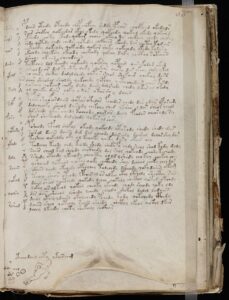 fictitious plants, astrological symbols etc.” Whatever language this was, the people read from left to right like we do in English. For the purpose of identification, the manuscript is named after Wilfrid Voynich, a Polish book dealer who purchased it in 1912. Seeing the value of the manuscript, it ws decided that it should be held in Yale University’s Beinecke Rare Book and Manuscript Library, where it has been since 1969.
fictitious plants, astrological symbols etc.” Whatever language this was, the people read from left to right like we do in English. For the purpose of identification, the manuscript is named after Wilfrid Voynich, a Polish book dealer who purchased it in 1912. Seeing the value of the manuscript, it ws decided that it should be held in Yale University’s Beinecke Rare Book and Manuscript Library, where it has been since 1969.
While the Voynich manuscript has been studied by many professional and amateur cryptographers, including American and British codebreakers from both World War I and World War II, it has never been demonstrably deciphered, and none of the many hypotheses proposed over the last hundred years has been independently verified. To this day the mystery of its meaning and origin has remained just that…a mystery, and very likely it always will be. It is my thought that this was an obscure and long-lost language, possibly a journal of some sort, but then, you guess is as good as mine.
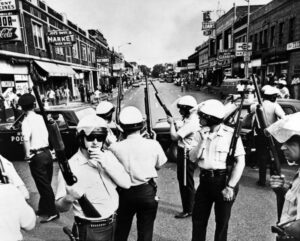
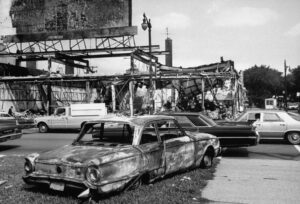 There have been times in the history of our nation, when peace seemed to reign in the land, and then there have been times, when chaos was the word of the day. in 1967, chaos was definitely the word of the day…in Detroit, Michigan, anyway. In 1967, Detroit was a city that was struggling economically, and racially. During that time, vice squad raids, looking for illegal drinking establishments in the city’s poorer neighborhoods were common, and people were in a state of high irritation.
There have been times in the history of our nation, when peace seemed to reign in the land, and then there have been times, when chaos was the word of the day. in 1967, chaos was definitely the word of the day…in Detroit, Michigan, anyway. In 1967, Detroit was a city that was struggling economically, and racially. During that time, vice squad raids, looking for illegal drinking establishments in the city’s poorer neighborhoods were common, and people were in a state of high irritation.
During one particular raid that occurred at 3:35am on Sunday morning, July 23, 1967, the Detroit Police Department moved in against a club that was hosting a party for returning Vietnam War veterans. The early-morning police activity angered a crowd of onlookers, and before long, the situation became explosive. Before long, thousands of people had rushed out onto the street from nearby buildings. The crown began throwing rocks and bottles at the police, who quickly fled the scene. Getting rid of the police, however, didn’t resolve the situation. The crowd began looting on 12th Street, where the club was located, and a number of shops and businesses were completely trashed!!
By sunrise, fires began breaking out and before long, the whole street was on fire. By midmorning, the police were finally called back to the scene, but controlling the crowd proved to be a major struggle. Unfortunately, getting the situation under control proved to be much more difficult than getting it started. The rioting continued all week, in the end, the US Army and the National Guard were called in to stop the worst of it. Five days later, when the bloodshed, burning, and looting ended, 43 people were dead and many more were seriously injured. In all, approximately 1,400 buildings had been burned or ransacked.
Crowds can quickly get out of control, but sometimes the fault lies equally between crowds and police. In this case, the Detroit Police Department was run directly by the mayor, and prior to the riot, Mayor Cavanagh’s appointees, George Edwards and Ray Girardin, worked for reform. Edwards even tried to recruit and promote black police officers in an effort to help quell racial tensions, but in what might be his biggest mistake, he refused to establish a civilian police review board, which the African American population had requested. He was trying to discipline police officers accused of brutality, and in doing so, he turned the police department’s rank-and-file against him. Many whites perceived his policies as “too soft on crime.” The Community Relations Division of the Michigan Civil Rights Commission, in a study in 1965 of the police, which was published in 1968, claimed the “police system” was at fault for racism. They blamed the police system was blamed for recruiting “bigots” and reinforcing bigotry through the department’s “value system.” President Johnson’s Kerner 
 Commission conducted a survey that found that prior to the riot, 45 percent of police working in black neighborhoods were “extremely anti-Negro” and an additional 34 percent were “prejudiced.” I suppose some might say that the fault of the riot was the police, but to a degree, they were doing their jobs too. Maybe it was the way the did it, and the fact that they ran when it got out of hand. Whatever the case may be, the outcome was horrific.
Commission conducted a survey that found that prior to the riot, 45 percent of police working in black neighborhoods were “extremely anti-Negro” and an additional 34 percent were “prejudiced.” I suppose some might say that the fault of the riot was the police, but to a degree, they were doing their jobs too. Maybe it was the way the did it, and the fact that they ran when it got out of hand. Whatever the case may be, the outcome was horrific.

 It is amazing to me that the ideas of one person can change the world, a nation, state, or city. Sometimes the changes are good, and sometimes they are horrible. During the early years of the Old West, besides fighting with the American Indians, there were those who felt like the buffalo were a big problem too. General Philip Sheridan said, “Let them kill, skin, and sell until the buffalo is exterminated, as it is the only way to bring lasting peace and allow civilization to advance.” His idea created a frenzy of hunters, intent on ridding the country of the buffalo. The buffalo, at that time an estimated 50-60 million of them, roamed freely in the Great Plains before white settlers began to push into the vast west in any great numbers. The buffalo were a vital food source for the American Indians hunted them for food and other necessities, and a harmonious ebb and flow between man and beast prevailed.
It is amazing to me that the ideas of one person can change the world, a nation, state, or city. Sometimes the changes are good, and sometimes they are horrible. During the early years of the Old West, besides fighting with the American Indians, there were those who felt like the buffalo were a big problem too. General Philip Sheridan said, “Let them kill, skin, and sell until the buffalo is exterminated, as it is the only way to bring lasting peace and allow civilization to advance.” His idea created a frenzy of hunters, intent on ridding the country of the buffalo. The buffalo, at that time an estimated 50-60 million of them, roamed freely in the Great Plains before white settlers began to push into the vast west in any great numbers. The buffalo were a vital food source for the American Indians hunted them for food and other necessities, and a harmonious ebb and flow between man and beast prevailed.
That was about to change after the Civil War, as more and more people moved westward. As the migration progressed, new army posts were established, and at the same time came the need for food and supplies for the soldiers. So, the army contracted with local men to supply buffalo meat to feed the troops. Then came the construction workers for the railroad, and a greater need for food. General Sheridan considered the buffalo a nuisance animal, as so was all for the slaughter of the buffalo. The buffalo coats could also supply the army and contractors with buffalo robes that could be used as coats and lap robes when riding in sleighs and carriages. These events put many a man to work as buffalo hunters. Because many people needed work, the offer of work came as a welcome prospect.
Leavenworth, Kansas, soon became a trading center for the buffalo hides, and tanneries found even more, uses for the material. Soon, things such as drive belts for industrial machines and grinding buffalo bones into fertilizer because common practices. In some places, buffalo tongues became a delicacy in fine restaurants. Personally, I would have to call things like at that one…disgusting!! Even though I know that some people like them. Before long the demand was so high that year-round work was available for buffalo hunters.
At the time of this offering, the economy was depressed after the Civil War, so many of the “tough” men decided to earn their living as a buffalo hunter. They had families to support, and so they went out, armed with powerful, long-range rifles. Each individual hunter could kill as many as 250 buffalo a day. Tanneries paid as much as $3.00 per hide and 25¢ for each tongue, which made a nice living for hundreds of men, including Wyatt Earp, Bat Masterson, Pat Garrett, Wild Bill Hickok, and William F Cody, just to name a few. Sadly, the meat wasn’t treated as well. All they wanted were the hides and tongues, so the rest of the edible buffalo meat was often left to rot on the Plains. Such a horrific waste. Over 5,000 hunters and skinners were involved in the trade by the 1880s.
Of course, to the Indians, this horrific slaughter was as heinous a crime as there ever could be. The majestic buffalo, who had often given their lives to supply the tribe with much needed food and blankets were being killed as if it was nothing more than sport. The air took on an almost carnival atmosphere when railroads began to advertise “hunting by rail.” Whenever the trains encountered a herd of buffalo crossing the tracks, it started a shooting spree. The sporting men would shoot hundreds of buffalo for fun, and then the trains would roll away, leaving the dead animals where they fell.
As you would expect, the Indians grew more and more angry and this senseless slaughter. They were, after all, watching their main source of food laying waste on the prairie. Their anger led to more Indian attacks on the White Man, which resulted in US Army retaliation at the height of the Indian Wars. Before long, the US Government decided that they needed to separate the Indians from the rest of “civilization” by placing them on reservations. To force the Indians onto the reservations, they needed to get rid of most of their food source, so US Army aggressively pursued a policy to eradicate the buffalo, which would force them onto reservations in order to survive.
Finally, the Texas Legislature began discussing a bill to protect the buffalo. Of course, General Sheridan defended the buffalo hunters and opposed the bill by saying, “These men have done more in the last two years and will do more in the next year to settle the vexed Indian question than the entire regular army has done in the last forty years. They are destroying the Indians’ commissary. And it is a well-known fact that an army losing its base of supplies is placed at a great disadvantage. Send them powder and lead, if you will, but for lasting peace, let them kill, skin, and sell until the buffalos are exterminated. Then your prairies can be covered with speckled cattle.”
Finally, in 1884 the era of the buffalo slaughter ended, and nothing remained of the massive buffalo herds but 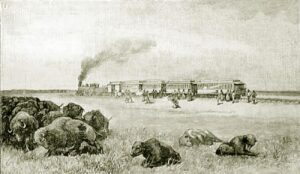
 piles of bones. By then, there were only about 1,200-2,000 surviving buffalo left in the United States. Through the continuing management efforts, there are currently 500,000 buffalo in the United States, including about 5,000 in Yellowstone and 1,000 in the Black Hills. These days, there are buffalo in every state.
piles of bones. By then, there were only about 1,200-2,000 surviving buffalo left in the United States. Through the continuing management efforts, there are currently 500,000 buffalo in the United States, including about 5,000 in Yellowstone and 1,000 in the Black Hills. These days, there are buffalo in every state.

